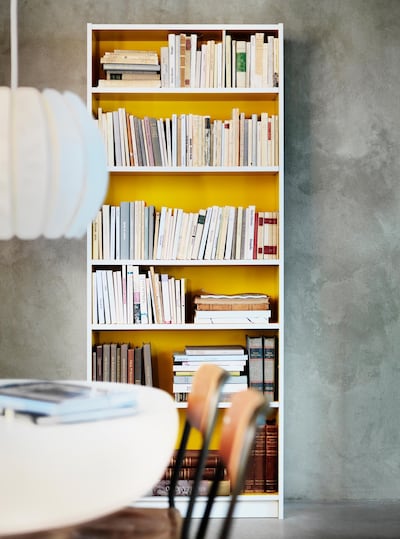The Billy Bookcase. The Kalax shelving unit. The Poäng chair. For home interiors lovers the world over, these familiar names can only mean one thing: Ikea. The brand came from humble beginnings, launching in Sweden in 1943, and opened its first store in Dubai in 1991. Today it boasts 411 shops in 49 countries across the globe. Whatever your personal taste, there’s no denying that Ikea is a giant of the design world.
I wonder if its founder, Ingvar Kamprad, who passed away this week at the age of 91, knew the impact he would have? He was just 17 when he set out “to create a better everyday life for the many people” and I would argue that he has done just that.
To me, Kamprad was successful not simply because he built a business empire. Yes, the numbers are impressive. Between September 2015 and August 2016 alone, the Ikea website attracted an incredible 2.1 billion visitors, while the brand’s retail sales for 2016 came in at $43 billion. But there are others who have achieved similar feats. What Kamprad did that so few other designers have been able to, was bring style to the masses, democratising design by making it affordable.
I remember as a teenager, leafing hungrily through each new catalogue as it came out, planning the home I would one day have. I couldn’t wait to fit my clothes neatly into a cleverly divided Pax wardrobe, arrange my books on a set of simple Lack floating shelves, and decorate my walls with pictures mounted in stark black Ribba frames.

IKEA has always encouraged this sort of dreaming, not only through its catalogue but with exceptionally clever shop floor displays. Rather than have endless shelves crowded with stock, they use mini showrooms to display their wares and help customers visualise their uses, before sending them to the warehouse to pick up whatever they decide to buy.
That’s another way Ikea broke the mould - by making flatpack cool. It never apologised for asking its customers to get handy with an Allen key and a set of wooden dowels. Instead, it was called a customer focused strategy designed to save us money by not charging us for stuff they were sure we were quite capable of doing ourselves. In fact, the company does a great job of making us feel like we’re a part of the Ikea family - its loyalty card is even called the IKEA Family card.
But the main reason why I believe IKEA has enjoyed such huge success is because it has largely ignored trends and has instead relentlessly stuck to its principles of simple design, affordable prices, minimal extras and proud Swedish branding.
Sure there have been variations and updates and new lines. It has listened to its customers and delivered an embellishment here, or a touch more pattern there. But while fashions have come and gone, Ikea has calmly continued to produce a range of products - currently numbering over 12,000 - all of which are identifiable as being part of a single design family. These include both basics and iconic pieces that compete with items by other brands with much higher price tags. For Ikea, Scandi chic isn’t a passing phase, it’s a way of life.
I remember interviewing one of the brand’s designers years ago. Maria Vinka was responsible for the quirky Gullholmen rocking chair, among other things, and told me: “I’m not into fads.” A self-confessed pack rat and mum of three, she was inspired by creating authentic pieces for real homes and admitted her own house was certainly “not a showcase”.
While she wasn’t speaking for the brand as a whole, I think her words fit the ethos that Kamprad was trying to bring to the world. That you don’t need a lot of money - or indeed a lot of space - to express yourself and create a beautiful home, and that ‘beauty’ is as much about comfort and pleasure as it is style.
As it says on the Ideas section of the IKEA website: “We don’t believe in perfect homes. We believe in homes that are a perfect reflection of the people who live inside. Where everything looks the way you want it to, works the way you need it to, and just generally makes you feel good – without costing a fortune.”
Perhaps that’s why the recent upcycling trend has adopted IKEA as an unofficial partner, with a growing group of ‘IKEA hackers’ using the brand’s products as a base for creative projects. A quick search on Pinterest will provide thousands of ideas for turning Ekby Alex drawer units into make-up tables, for example, and using Ribba picture ledges to store shoes.
______________
Read more:
Even though many of us rent in the UAE, it's still worth turning your house into a home
Ingvar Kamprad: The man who revolutionised the way we live
Remembering the man who made his brand a household name
Ikea and the UAE: a love affair that needed room to grow
______________
There have been criticisms of the IKEA model, of course. That it’s too simplistic, too cheap, that having to battle complex instructions or find your way out of the maze-like shop floor is too frustrating. But wherever there is success, you will find criticism. The instructions aren’t so bad, if you take your time and make sure you have all the bits the right way round. And in recent years, they’ve built escape routes into the store layouts.
Personally, I have only grown fonder of the brand as I’ve got older. I may have a bigger budget than I did as a teenager, but I still appreciate great value and simple style, and there’s no doubt that’s what IKEA provides. That, and a really excellent plate of meatballs.





